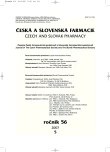Effect of thermal curing of the ethyl cellulose film on the rapidity of release of diclofenac sodium from pellets
Vliv tepelného ošetření ethylcelulosového filmu na rychlost uvolňování sodné soli diklofenaku z pelet
Pelety opatřené obalem řídícím uvolňování léčiva jsou oblíbenou perorální lékovou formou používanou v medicínské praxi. V současné době se dává přednost obalům z nerozpustných polymerů naneseným na účinné pelety ve formě vodných disperzí. Vodné disperze polymeru se však v průběhu procesu obalování i po něm chovají jinak než jejich roztoky v organických rozpouštědlech. Vznik stabilního filmu na povrchu pelet je podmíněn koalescencí kapek při optimální teplotě. Experimentální studie se zaměřila na sledování změn disolučních profilů sodné soli diklofenaku z obalených pelet při různém tepelném ošetření polymerových obalů z vodné disperze ethylcelulosy (1–72 hodin při teplotě 60 °C). Rychlost uvolňování léčiva se s rostoucí dobou ošetření obalu zpočátku snižovala. Disoluční křivka vzorků ošetřovaných po dobu 24 hodin se nejvíce blížila přímce, při delším zahřívání se léčivo uvolňovalo opět rychleji. Vzorky obalených pelet naplněné do tvrdých želatinových tobolek, zabalené do blistru se uložily do tří stabilitních režimů (25 °C/ 60 % vzdušné vlhkosti, 30 °C/ 65 % vzdušné vlhkosti, 40 °C/ 75 % vzdušné vlhkosti) a sledovaly se po dobu šesti až dvanácti měsíců. Nejlepších výsledků dosáhl vzorek s izolační vrstvou a obalem ošetřeným při 60 °C po dobu 24 hodin.
Klíčová slova:
pelety – vodná disperze ethylcelulosy – tepelné ošetření obalu – disoluční profil léčiva – stabilita
Authors:
E. Gryczová 1; M. Rabišková 1; V. Tomášek 2; A. Prokopová 2; L. Cepáková 1
Authors‘ workplace:
Veterinární a farmaceutická univerzita Brno, Ústav technologie léků
1; Zentiva a. s., Praha
2
Published in:
Čes. slov. Farm., 2007; 56, 235-242
Category:
Original Articles
Overview
Coated pellets controlling drug release are a very popular dosage form which is widely used in medical practice. At present the coatings of water-insoluble polymers formed from aqueous dispersions are preferred. However, film formation from an aqueous polymeric dispersion is different from that from their organic solutions. A stable film on the pellets surface is produced by coalesces of discrete latex particles at an optimum temperature. The present experimental paper studied the changes of diclofenac sodium dissolution profiles from coated pellets, when their coatings from an aqueous polymeric dispersion of ethyl cellulose were cured for different time periods (1–72 hours) and a temperature of 60 °C. Drug release rate was decreasing with the increasing time of the layer curing up to 24 hours. At this time the dissolution curve was similar to a strait line. When the curing time further increased, the drug release was again faster. All prepared samples (with or without seal coat, cured for a period of 24 hour or uncured) were filled into hard gelatine capsules and stored in blisters in three different stability boxes (25 °C/60 % RH, 30 °C/65 % RH, 40 °C/75 % RH) for 6 or 12 months. The best drug dissolution profile and stability were observed for the pellets with the seal coat and ethyl cellulose coating cured for 24 hours.
Key words:
pellets – water dispersion of ethyl cellulose - curing – drug dissolution profile – stability
Labels
Pharmacy Clinical pharmacologyArticle was published in
Czech and Slovak Pharmacy

2007 Issue 5
Most read in this issue
- Mucoadhesive tablets for oral administration of ciclopiroxolamine
- Oxidative stress and its role in respiratory diseases
- Cytochrome P450 3A polymorphism and its importance in cyclosporine and tacrolimus therapy in transplanted patients
- Determination of valproic acid by on-line coupled capillary isotachophoresis with capillary zone electrophoresis with conductometric detection
